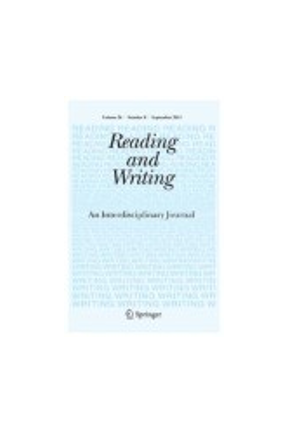In unserem Netzwerk ist 2022 erschienen:
Haase, Astrid; Steinbrink, Claudia (2022): Associations between morphological awareness and literacy skills in German primary school children: the roles of grade level, phonological processing and vocabulary. In: Read Writ 35 (7), S. 1675–1709. DOI: 10.1007/s11145-021-10247-1.
»Studies investigating relations between morphological awareness and literacy in German, a language with a rather transparent but asymmetric orthography, are sparse. Little is known about the role of grade level for these relationships and of their relative strength compared to those between other language-related variables and literacy skills. This cross-sectional study was conducted with German-speaking second-, third- and fourth-graders (n of final sample ≥ 85 per grade). Morphological awareness tasks required the production of inflections, derivations and compounds. Additionally, phonological processing, vocabulary, reading fluency, reading comprehension and spelling were measured. Factor analyses revealed two facets of morphological awareness: morphological fluency and morphological awareness for pseudowords. These were correlated with both reading and spelling skills in all grades. More literacy variables were related to morphological fluency in Grade 4 than in Grades 2 and 3. In regression analyses, variance in literacy skills was predominantly explained by phonological awareness. Morphological awareness did not explain additional variance. The results reveal that different facets of morphological awareness are related to literacy skills in German primary school children. Despite the asymmetry of German orthography, no evidence was found for differences in the association of morphological awareness with spelling versus reading. Phonological processing shows stronger relations with literacy than morphological awareness does. This might indicate that in the transparent German orthography, alphabetic reading and spelling strategies are particularly relevant until the end of Grade 4. Yet, morphological fluency might start to unfold its relevance for reading and spelling near the end of fourth grade in German.«


In unserem Netzwerk ist 2022 erschienen:
Haase, Astrid; Steinbrink, Claudia (2022): Associations between morphological awareness and literacy skills in German primary school children: the roles of grade level, phonological processing and vocabulary. In: Read Writ 35 (7), S. 1675–1709. DOI: 10.1007/s11145-021-10247-1.
»Studies investigating relations between morphological awareness and literacy in German, a language with a rather transparent but asymmetric orthography, are sparse. Little is known about the role of grade level for these relationships and of their relative strength compared to those between other language-related variables and literacy skills. This cross-sectional study was conducted with German-speaking second-, third- and fourth-graders (n of final sample ≥ 85 per grade). Morphological awareness tasks required the production of inflections, derivations and compounds. Additionally, phonological processing, vocabulary, reading fluency, reading comprehension and spelling were measured. Factor analyses revealed two facets of morphological awareness: morphological fluency and morphological awareness for pseudowords. These were correlated with both reading and spelling skills in all grades. More literacy variables were related to morphological fluency in Grade 4 than in Grades 2 and 3. In regression analyses, variance in literacy skills was predominantly explained by phonological awareness. Morphological awareness did not explain additional variance. The results reveal that different facets of morphological awareness are related to literacy skills in German primary school children. Despite the asymmetry of German orthography, no evidence was found for differences in the association of morphological awareness with spelling versus reading. Phonological processing shows stronger relations with literacy than morphological awareness does. This might indicate that in the transparent German orthography, alphabetic reading and spelling strategies are particularly relevant until the end of Grade 4. Yet, morphological fluency might start to unfold its relevance for reading and spelling near the end of fourth grade in German.«